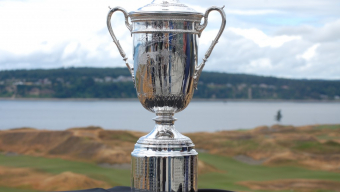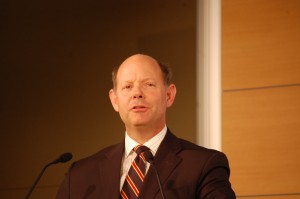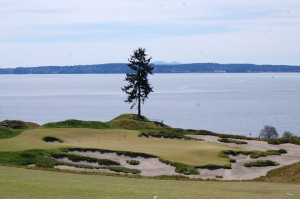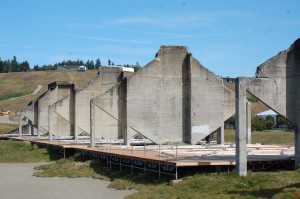UNIVERSITY PLACE, Wa. – Mike Davis, the executive director of the United States Golf Association, carries himself as a man very much in charge.
He does because he is.
No one has had more impact on the 2015 U.S. Open at Chambers Bay golf course in mid-June than Davis. Monday, he was part of a USGA delegation gathered at the course for a media event.
It was Davis, nine months after the course was opened in 2007, who decided that the layout would be fit and ready for the Open eight years later. That was highly unusual for a new course but Davis believed in its possibilities.
He has since directed a vast multitude of changes from the original design by the Robert Trent Jones Sr. team. New tees were added, greens reshaped, greens torn up and redone, pars changed, bunkers added or extended and a host of micro-managed fixes.
One of his biggest decisions – one in which jury is still out on – is going with a thick rough on this links course. It wasn’t designed that way. Most links courses generally don’t have roughs of much consequence.
But Davis wanted to present more challenges for the world’s best golfers, as if 7,600 yards and wildly undulating fescue greens were not enough.
“You think about the test of golf and accuracy and it playing kind of like a links course and thinking in your mind like a British Open course, we think some rough is appropriate,” Davis said. “We think that we still want to test accuracy off the teeing ground.
“We do plan to graduate it. But so we want, if a player misses in the rough close in, that you’re going to get a little grass between the ball and the club head, which will take away from the distance control, but allow the player to try to play towards the green. That’s the intent.”
The rough is quite green and thick at the present time and takes a mighty hack to get out of it. If you can find your ball. As one caddy described it, “it’s a catcher’s mitt.” It just disappears.
But Davis said that’s not necessarily how it will play for the Open. He said the maintenance crew likely will cut it back to the point that balls won’t be readily lost and players can return to the fairway without a using a canon.
The architect, Jones, who was on hand for the event, did not design it for a rough. Yet he has a close relationship with Davis and does not have any open disagreements with its introduction.
“I’ve done my part. It’s in their hands,” Jones has said. “I’m the composer. He’s (Davis) the conductor and the players make the music.
“They (pros) can’t stand up and hit without thinking. They have to think about direction. It may run out 50 yards and into a hazard or sandy wasteland. The fact that the USGA is growing out the rough is a little bit of an interpretation of my music, in that it might slow down and stop in the rough. Mike talks to that point, in setting of the course for the Open.”
Davis defends the rough by using No. 7 as an example. It is a 482-yard par 4, dogleg to the right. If a player drives the ball straight and long off the tee, there’s a good chance it will skip across the fairway and into the rough. That where Davis has allowed a punitive rough to fill in.
“I think coming into this we looked at each hole, hole by hole, and as I mentioned it’s the widest course we have ever had,” Davis said. “But you take some of the holes as an example, where the seventh hole would be a pretty good example, it’s a dogleg (right), a little bit of a cape architectural feature to it.
“There we grew some rough in the left side simply to say, if you got the ability to curve your ball left-to-right, you’re going to get an advantage.”
Generally, the rough should not be a constant problem for the professionals if they keep their shots fairly straight. It’s a wide course. Davis has brought the rough in play for the occasional erratic. In the previous seven years of this course it hasn’t been this close, even for the 2010 U.S. Amateur.
“This was a golf course designed in a wonderful way, and it was very open, almost to the point where you couldn’t get yourself off a closely mown area unless you hit an errant shot up into one of the dunes,” he added.
“Now, it won’t necessarily happen 100 percent of the time, but that’s the intent. We just felt that to have it all closely mown fairways, for what we were trying to do, just didn’t quite work for at least a U.S. Open.”
Each day during the tournament, Davis and his team also will have a significant impact – perhaps more than any previous Open layout – on the how the players can attack the course. Each hole has a what Jones calls “a ribbon tee,” which means the markers can be placed anywhere along a strip of green that could run up to 50 yards. There are a variety of pins that can be reached in different ways, particularly through the inventive use of the terrain.
Also, par for the first and the 18th holes can be switched from day to day. One day, the first hole can be a par-5 and the 18th a par-4. The next day, just the reverse. No one can remember if that option has even been available at the previous 114 Open courses.
“Why did we do that?” Davis said. “We weren’t trying to be innovative; we weren’t trying to be cute. It all got down to the architecture of the course. It gives so much wonderful flexibility that the drive zones as a par-4 and par-5, for both those holes, are completely different.
“And they play different. There’s a risk-reward element to both holes.”
One element that won’t change for this U.S. Open, the first in the Northwest, is the chirping. Some players are not going to like Chambers Bay. You never can please everyone. They’re complain about the rough, the fairly severe green and fairway undulations, the all-fescue grass, the length, the design, the temporary clubhouse, the coffee or shape of their breakfast bagels.
“This is a one of a kind site for us at a U.S. Open. There’s going to be some players who just love this ground game, who love the imagination, who as I say, embrace it,” Davis said.
“Then there’s other players who they just want predictability. They want something right in front of them. They don’t want to have to guess what’s going to happen when their ball lands,” he added. “So it would not be a U.S. Open if we didn’t get some chirping. It’s just a part of it. And we accept that. We joke internally sometimes that if nobody’s complaining, we have done something wrong.”
























